Reverse Symmetry
Reverse symmetry is not a new concept. It's been known for centuries...Reverse symmetric starting positions have a unique feature, both White and Black players have the same view of the board, both of their own pieces, as well as for the enemy army.
Chaturanga, the oldest known form of chess, used basic reverse symmetry:
 ....
....
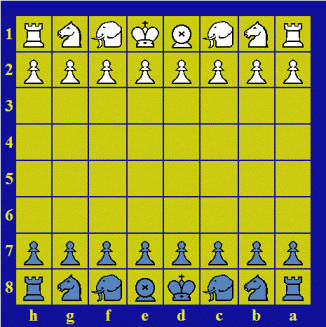
The left diagram shows the Chaturanga intial layout from White's point of view, while the one on the right shows it from the Black point of view. Notice that from both White's point of view the Rooks, Knights and Elephants are symmetrical accross the board. The King and the Counselor are in the middle two squares of the first rank, with the Counselor always to the left of his King. The same statements are all true from Black's point of view as well. This is reverse symmetry!
Thai Chess (Makruk) is another ancient variant that displays reverse symmetry: (traditional Thai set on the left, western pieces in the middle, Game Courier's Makruk preset on the right)
 ....
....  ....
.... 
Here the King and Queen are in the middle two squares of the first rank, with the King to the left of the Queen from both players perspectives.
Japanese Chess (Shogi) is another oriental and ancient variant that displays reverse symmetry: (traditional Japanese set on the left, western pieces representation on the right)
Look at the Bishop and the Rook in the second row, with the Bishop to the left of the Rook from both players perspectives.
The Emperor's Game, is a variation played on a 10x10 board invented by L. Tressan of Leipzig, Germany in 1840, that displayed a more complex reverse symmetry:
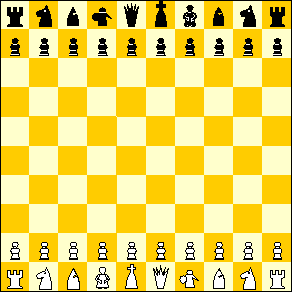
Look at the middle 4 squares on each players' first rank. On these squares, from both White and Black's perspectives they see the General (Queen+Knight) to their left, followed by the King, the Queen and finally the Adjutant (Bishop+Knight) rightmost. Reverse symmetry!
Robert Abbott's 1962 creation Ultima shows reverse symmetry:
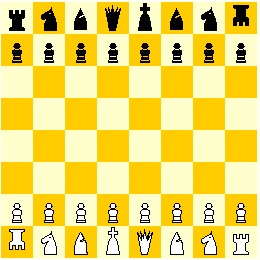
Abbott initially called the game Baroque, but later included it in his 1963 book "Abbott's New Card Games" under the title of 'Ultima'.
Gabriel Vicente Maura's 1968 creation Modern Chess is a game that displays a simpler reverse symmetry:
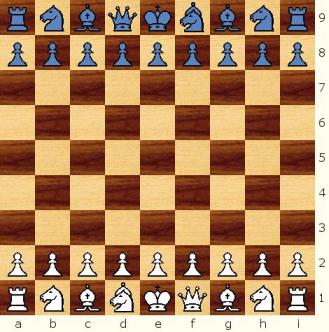 ....
....
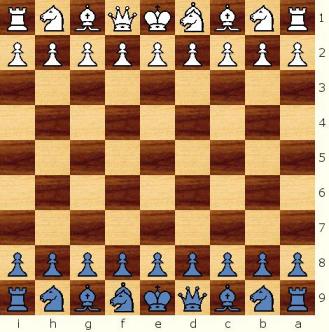
This time from both White's and Black's point of view, the Rooks, Knight's and Bishops are placed symmetrically accross the board, the King, Queen and Prime Minister (Bishop+Knight) are in the middle three squares of the first rank, with the King in the middle, the Queen to his right and the Minister to his left.
Wildebeest Chess is a large (11x10) chess variant invented in 1997 by R. Wayne Schmittberger from the Netherlands that also features reverse symmetry:
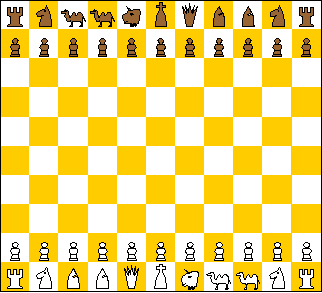
The Sissa chess variant invented by Carlos Cetina from México in 1998 also displays reverse simmetry on a 9x9 board:

Here in the starting position the Queen is to the left of the King, and the Sissa to the right of the King, from both players perspective.
Mir Chess 32 (2005, below left) and Midgard Chess (2007, below right) are two games by David Paulowich from P.E.I., Canada, that also have reverse symmetrical setups:


Prime Ministers Chess is a 9x8 adaptation of Maura's Modern Chess that also displays the same reverse symmetry:

Courier Chess Moderno (12x8) and Modern Ministers Courier Chess (11x8) are Courier Chess variations that also displays reverse symmetry:
 ....
....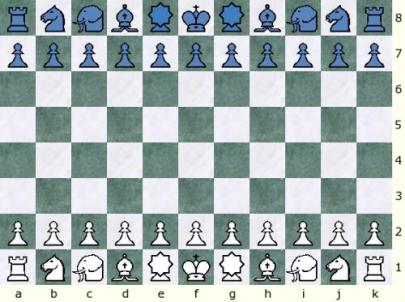
A couple of the Azchess setups, and all the AzsymChess variants by Namik Zade (2006), display reverse symmetry:
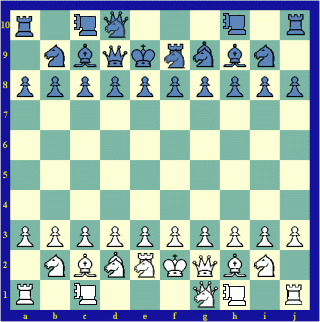

Here is one of the reverse symmetrical setups for Displacement Chess 2 by Charles Daniel (2008):

Another variation (which is based on an ancient historical game) with reverse symmetry is Latrunculi XXI by Jose Carrillo (2015):

What was probably not done before was to apply the reverse symmetric concept to random chess variants.
Modern Random Chess (MRC), Contemporary Random Chess (CRC), Prime Ministers Contemporary Random Chess (PM-CRC), Modern Capablanca Random Chess (MCRC), International Contemporary Random Chess (ICRC) and Modern English Random Chess (MERC) are all new variants that use reverse symmetric layouts.
Setup
Reverse Symmetry
In a 9x9 board reverse symmetrical setup the piece at the square a1 for White, is the same as the piece at i9 for Black. The piece at b1 for White is the same as the one at h9 for Black, and so on. The Pawns are in the second row of each player’s side.
Let looks at an example, from both White and Black’s point of view:
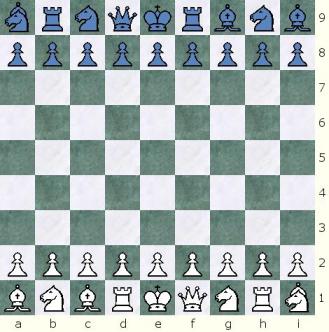 ....
....
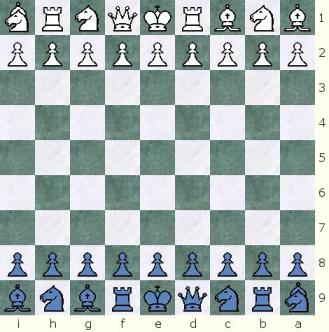
In the Modern Random Chess position on the left, from White’s point of view, the Bishops are both on his leftmost dark squares, his Queen is to the right of the King, his Prime Minister is on his right corner, and so on. Also, from White’s point of view, his opponent’s Minister is on the opposite corner across the diagonal as his own, the opponents Queen is across the board from the Rook to the left of his King, and you could continue to describe the position of the opponent’s pieces in relation of White’s own.
Now look at the same MRC position in the diagram on the right, but from Black’s point of view. Every single observation made from White’s point of view above, applies as well to the point of view from Black. Reverse symmetry!
In a standard 8x8 board reverse symmetrical setup the piece at the square a1 for White, is the same as the piece at h8 for Black. The piece at b1 for White is the same as the one at g8 for Black, and so on. The Pawns are in the second row of each player’s side.
Let looks at the Contemporary Random Chess example below, from both White and Black’s point of view:
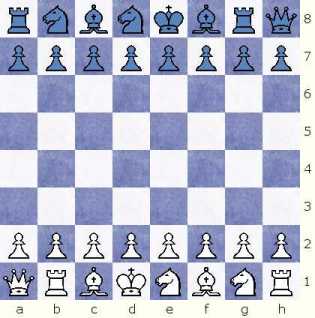 ....
....
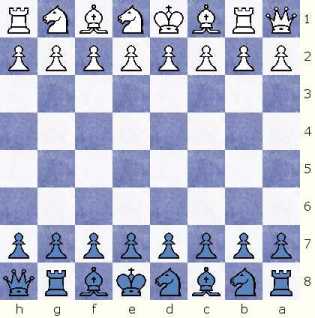
In the CRC position on the left, from White’s point of view, the Queen is on the leftmost square next to a Rook, his 2nd Rook is on his rightmost square next to a Knight, the Bishops are on their traditional Orthodox Chess initial squares, the King has a Knight to his right, and so on. Also, from White’s point of view, his opponent’s opponents King is across the board from the Knight to his right, the Bishops are across the board to each other, the Queen is on the other corner of the same long diagonal as his own Queen, and you could continue to describe the position of the opponent’s pieces in relation of White’s own.
Now look at the same CRC position in the diagram on the right, but from Black’s point of view. Every single observation made from White’s point of view above, applies as well to the point of view from Black.
More sample random setups with reverse symmetry: 'Prime Ministers Contemporary Random Chess' (8x8) and 'Modern Capablanca Random Chess' (10x8).
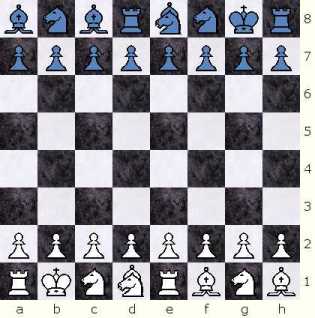 ....
.... 
International Contemporary Random Chess (10x10) and Modern English Random Chess (10x10):
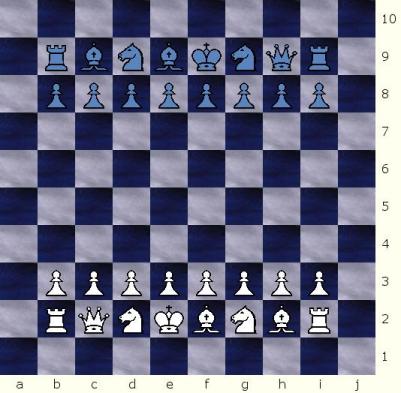
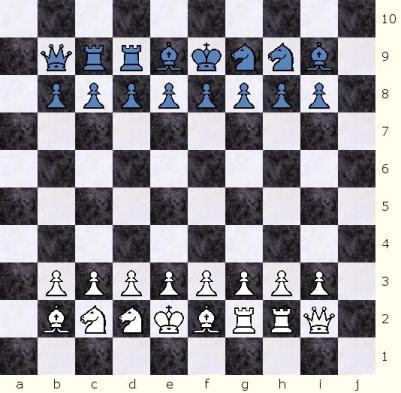
Notes
I didn't invent the concept of reverse symmetry. Like I said before, it's been known for centuries.What I did do was to identify the concept of reverse symmetry and apply it to random chess variants.
I'm a fervent player of Fischer Random Chess. When I discovered Maura's Modern Chess early in 2008, I decided to adapt to the game some FRC concepts, and after identifying reverse symmetry, Modern Random Chess was born.
My next reverse symmetric "accidental" discovery was Contemporary Random Chess, which I found after setting up the new Bishop Ajustment Rule.
Modern Capablanca Random Chess is my random adaptation of the four 'Modern' chess principles to the great José Raúl Capablanca's 10x8 game. Prime Ministers Chess (9x8), Prime Ministers Contemporary Random Chess (8x8), International Contemporary Random Chess (10x10) and Modern English Random Chess (10x10) are my last variants to join the reverse symmetric group.
José Manuel Carrillo-Muñiz, from Puerto Rico
May 2008
Chess Variants by the Author:
- Modern Chess Complex
- Modern Random Chess (9x9)
- Contemporary Random Chess (8x8)
- Prime Ministers Chess (9x8)
- Pseudo-Modern Random Chess (9x9)
- Chess8400 (9x9)
- Prime Ministers Contemporary Random Chess (8x8)
- Prime Ministers Random Chess (9x8)
- Hia Chess (9x8)
- Modern Capablanca Random Chess (10x8)
- English Chess Complex
- Modern English Random Chess (10x10)
- International Contemporary Random Chess (10x10)
- International Fischer Random Chess (10x10)
- Courier Chess Complex
- Courier Chess Moderno (12x8)
- Mini Courier Chess Moderno (10x8)
- Silver Elephant Chess (10x8)
- Modern Ministers Courier Chess (11x8)
- Ajax Complex
- Ajax Chess (10x10)
- Ajax Orthodox Chess (8x8)
- Ajax Random Chess (8x8)
- Ajax Modern Random Chess (9x9)
- Ajax Ministers Chess (10x8)
- Ajax Falcon Chess (10x8)
- Ajax-Capablanca Chess (10x8)
- Korean Random Chess (9x10)
- Latrunculi XXI (10x8)
- Partnership Chaturanga (8x8)
Other Presets by the Author:
- Modern Chess Preset
- Fischer Random Chess Preset
- Makruk (Thai Chess) Preset
- Ajax Xiangqi (9x10) proposed by Charles Gilman
- Ajax Bigamous Chess (9x8) by Carlos Cetina
- Ajax Euchess (10x10) by Carlos Cetina
- Frolov Chess - Ajax Variation (9x9)
- Hiashatar (Mongolian Decimal Chess) (10x10)
- Milenium 3D Chess (8x8x3) by William L. D'Agostino
Other Pages by the Author:
- How to Generate Random Positions
- The Bishop Adjustment Rule
- The Modern Principles
- Reverse Symmetry
- The Prime Minister
- The Courier Elephant
- The 10x8 Variants
- Checkers Variants
 This 'user submitted' page is a collaboration between the posting user and the Chess Variant Pages. Registered contributors to the Chess Variant Pages have the ability to post their own works, subject to review and editing by the Chess Variant Pages Editorial Staff.
This 'user submitted' page is a collaboration between the posting user and the Chess Variant Pages. Registered contributors to the Chess Variant Pages have the ability to post their own works, subject to review and editing by the Chess Variant Pages Editorial Staff.
By Jose Carrillo.
Web page created: 2008-05-17. Web page last updated: 2009-07-05